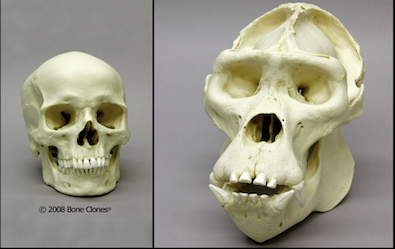The sagittal crest is marked on the gorilla skull with red color.

The sagittal crest is made of two parietal bones.
Zygomatic bones of gorillas look wider and more robust than the human ones. Gorillas have a larger zygomatic arch that has a bigger surface, more volume, and works as an attachment to facial muscles. The major function of the latter is to operate the jaw bones and realize chewing movements.
The other trains identified between two sculps are forehead absence in gorilla’s skull, large and distinguishing brow ridge (“supraorbital torus”), small bone structure case for brain compared to humans. Additionally, there were identified large canine teeth growing from a different angle at the gorilla’s skull and wide features of the gorilla’s skull compared to fragile and thin lines of the human skull.
In Figure 1, the male skull of a gorilla is presented as it has a more visible sagittal crest, large nuchal crest, more definite brow ridge. Usually, male skulls are bigger than female ones.
For gorillas, it was important to have strong chewing muscles, and in accordance with small brain size, it was leading to consequent changes such as sagittal crest formation and strengthening of the muscles. The latter allowed both gorillas and robust Australopithecus to have a stronger bite and chew force that was necessary according to their diets. That is why temporalis and masseter are so extensive, the force created by these muscles impacts bone structures and makes bones have various signs, such as sagittal crest.
Skulls of Homo erectus and modern humans are compared in the following table.
Relative brain size is calculated below:
Chimpanzee = 395/54 = 7.31 cc/kg
Gorilla= 506/120 = 4.22 cc/kg
- afarensis= 438/37 = 11.84 cc/kg
Paranthropus = 515/39 = 13.2 cc/kg
H. habilis = 631/42 = 15.02 cc/kg
H. erectus = 985/56 = 17.59 cc/kg
H. sapiens = 1325/63 = 21.03 cc/kg
The results of the calculation meet the expectations of the evaluation development. Homo sapiens has the largest relative brain size of all the species, and the gorilla has the smallest. The most significant increase in relative brain size occurred in the time of Australopithecus afarensis that show larger numbers of brain size characteristics compared to Chimpanzees.